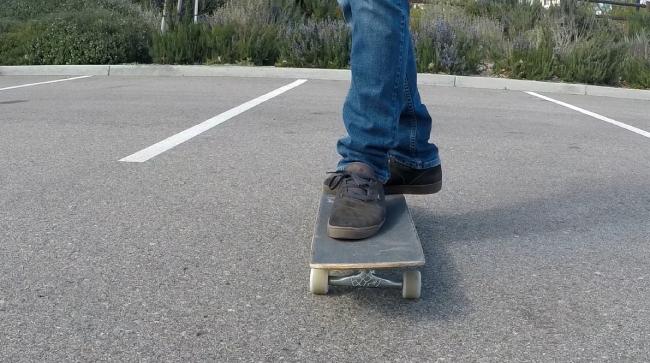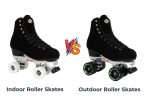You can ride your board at your desired speed by pushing yourself forward. You also learn to skate by rolling and getting up to speed.
It’s so exciting that you’re about to embark on this amazing journey! Keep going and you’ll be able to improve every day.
But how to push on a skateboard? Here’s our guide only for you!
Things to do before you try to push on a skateboard
Make sure you have the basics of shifting your weight
Almost everyone gets this wrong. Skate enthusiasts often put too much energy and weight into their back foot, which causes the board to go forward without them and the result is a fall.
Putting more pressure on your front foot is a simple way to visualize this but some may not feel comfortable doing this. Even bending your leg slightly will help you put enough pressure on it.
Be sure you can ride for more than a few feet before you fall off
Stay relaxed and make sure you know the basics first. This includes how to shift your weight and learn to balance on the board. Both will help you travel at least a few feet before falling.
How to Push on a Skateboard?
Step 1: Keep your front foot slightly below the front bolt.

Step 2: Keep the back foot right above the back bolt.

Step 3: Pivot the front foot so that it faces the nose of the board.

Step 4: Lift off the back foot and put it towards the side of the board.

Step 5: Use the back foot to push yourself forward off the ground.

Step 6: Lift the backfoot back onto the board and pivot the front foot back where it started.

Things to Focus On When Pushing on a Skateboard

- Stay relaxed
Relax being staying too focused on the form while skating can lead to injury.
Stretching before skating can help. Taking a skateboard lesson can be relaxing. It can also be meditative since skateboarding came from surfing.
- Shift your weight to the front foot when you pick the back foot up
Slide your foot across the ground as you stand on your board with the front foot forward. To move your leg back and forth, your weight should shift forward so that you can push more powerfully.
- Shift your weight to the back foot when it comes down and meets the ground
As the back foot comes down and hits the ground, shift the weight onto your back foot to push forward.
- Lift off most of the weight on the front foot until you push off with the back foot
Try to position most of your weight off the front foot until you start pushing with your back foot.
- Maintain center balance
When you are learning to skate, try to focus on your center of gravity so you don’t lose your balance and fall.
Position your front foot correctly and make sure that the center of gravity of your skateboard is over your front foot when you push off.
- Work on the extension of the back leg while balancing on the front foot
Once you have pivoted the foot, you pick up the back foot and shift all the weight to the front foot. Then as the back foot comes down again and hits the ground, you need to shift the weight back onto the back foot.
- Work on the reverse of the first position
Reverse the process by lifting your back foot onto the board. Now pivot your front foot back to the starting position.
- Push regularly and at your own pace
Practice while keeping a steady pace when you have reached the speed you desire. Then start manually when you are comfortable.
- Compensate the onboard leg by pushing down on your thigh with your hand
Board legs are subject to wear and tear because they bend and straighten under your weight. This is the leg that does most of the steering itself. You can compensate by pushing down on your thigh with your hand.
Common mistakes to avoid when pushing on a skateboard
Don’t try to push the board little by little
When pushing little bits at a time, you are not getting enough extension with your leg. Pushing gives you a few inches instead of a few feet for more speed and flow.
Don’t forget to have full balance and strength in the front foot
Practice by standing on the board and using the motion of pivoting the front foot forward. Then take your back foot off and try to remain balanced with all the weight going to the ball of your front foot.
Don’t forget to give enough extension to the back foot with your leg
While on the board, you need to allow plenty of extension with your foot so you can gain speed and momentum.
Why shouldn’t you push mongo?
Complicates things
There are more steps involved when skating mongo style. This complicates the process for reaction time, weight distribution, and center of gravity.
Looks silly
Its plain looks ridiculous. Avoid those crazy stares at the skate park and learn to push regularly.
Dangerous
Mongo style is dangerous as you have less time to prepare and react. It’s harder to make a correction when someone or something is in your pathway.
FAQs
1. Why does my board turn when I push?
Ans. Skateboards turn on their own. Some can be bad bearings, bent axles, coned wheels, squashed bushings, and loose screws. Even loose trucks and the deck itself can be to blame. Some boards will turn to the left on their own, while others will turn to the right.
2. How long does it take to get decent at skateboarding?
Ans. Skateboarding usually takes between 12 months and 3 years to master. However, it won’t take you more than 12 months to learn basic tricks.
3. How do I uphill a skateboard?
Ans. A good technique to master is alternately pushing with both feet, aka skogging (skate jogging). This is pushing normal, then you change to mongo.









Leave a Comment